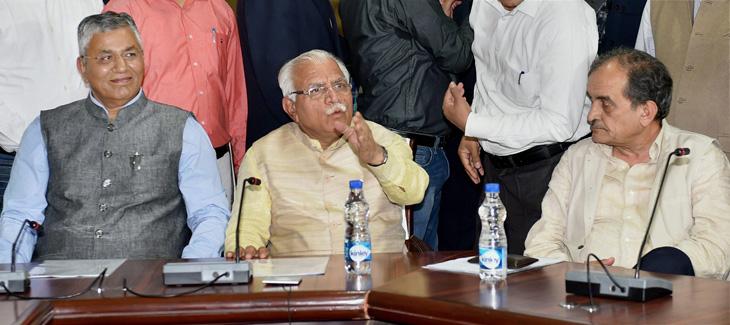Jat agitation: Haryana's 'positive' talks with agitators raise more questions than answers

There was a sigh of relief in Delhi and the rest of National Capital Region when agitating Jats in Haryana called off their 'Delhi kooch' and 'Parliament gherao' programme.
Following 'positive' rounds of talks with Chief Minister Manohar Lal Khattar, along with Union ministers Birender Singh and PP Chaudhary, the All-India Jat Aarakshan Sangharsh Samiti (AIJASS) President Yashpal Malik announced that the Haryana executive of the Samiti will meet on 26 March to decide on ending the ongoing dharnas across the state.
The core issues related to the Jat agitation stand exactly where they were. In fact, the recent developments have left them with more questions than answers to the unrest that continues to simmer in the state. And under these circumstances, the path ahead for Khattar does not look to be an easy one.
Khattar agreed to address the concerns of the Jat leaders in a time-bound manner. Reports said that the four key issues on which a consensus has been reached with the agitators are –
– Review of cases registered against agitators
– Jobs for the next of kin of killed or disabled during last year's agitation
– Compensation to those injured in the violence
– Initiating the process of including Jats in the central list of Other Backward Castes (OBCs) once the chairman and members of the National Commission for Backward Classes (NCBC) are appointed.
Stock issue
However, the core issue of reservation for Jats stands at a crucial juncture with the Punjab and Haryana High Courts having reserved its verdict on the petition challenging the constitutional validity of Haryana Backward Classes (Reservation in Services and Admission in Educational Institutions) Act, 2016 a fortnight ago.
The act providing reservation to Jat and five other communities under the newly-created backward classes (C) category was stayed some months ago as well.
A division bench headed by Justice SS Saron reserved the verdict after a marathon hearing of arguments placed by the Haryana government defending the act, and the petitioners questioning its legal validity.
The Haryana Backward Classes (Reservation in Services and Admission in Educational Institutions) Bill 2016 was passed unanimously by the state Assembly on 29 March 2016 and was notified on 12 May 2016.
The new Act provided reservation to Jat and five other communities under the BC(C) category. Five other communities include –
1. Jat Sikh
2. Mulla Jat/Muslim Jat
3. Bishnoi
4. Ror
5. Tyagi
All these six communities were entitled to get 10% reservation in government services and admission to educational institutions.
However, it was stayed on a PIL petition filed by Murari Lal Gupta of Bhiwani district who sought directions to set aside the Bill on the grounds that it was against the law laid down by the Supreme Court in the Indira Sawhney case.
The petitioner contested that after the passing of the new bill, the reservation reached around 70% which violates the Supreme Court judgement that had capped the limit at 50%.
He reportedly pointed out that in 2014 the state government had introduced such a Bill to include Jats in the list of OBCs but the Supreme Court had held that Jats were not backward socially, educationally or politically.
The Haryana government argued that keeping in view the geographical and cultural diversity of India, it is not necessary that there should be uniformity in the reservation policies. It cited the example of Tamil Nadu where the state has provided 69% reservation after constituting a commission. The government also said that it is mandatory for the petitioner to move the Haryana Backward Classes Commission in the matter.
Political analyst Balwant Takshak pointed out, “Even if the High Court comes out with a judgement in favour of the government granting reservations, the petitioner is most likely to go to the Supreme Court. The battle stays in court for now.”
What's next?
There has been a talk of taking the route of the Ninth Schedule to the Constitution to solve the matter but this route is easier said than done. Sources said that to include the Haryana quota law in the Ninth Schedule to the Constitution, a Constitution Amendment Bill is required to be introduced by the central government in the Parliament and passed in both the Houses by a special majority – which is by a majority of the total membership of that House and by a majority of not less than 2/3rd of the members of the House present and voting.
In addition to this, in the case of any disagreement between the two Houses, there cannot be a joint sitting of the Houses of Parliament on the Bill. This is because Article 368 of the Constitution requires each House to pass the Bill by a prescribed special majority.
Takshak pointed out, “Till now there has been no move by the Khattar government indicating that they might be willing to take this route. Otherwise, it would have written to the Centre on the issue by now. The BJP governments, both at the Centre as well as the state, stand in the dock on the issue as there has been hardly any progress made by the committee, under senior BJP leader Venkiah Naidu, that was announced with much fanfare during the Jat agitation last year.”
Just talk?

Even this time, the government has come under tremendous criticism for shifting goal posts while dealing with the agitating Jats. It had first constituted a committee under chief secretary DS Dhesi which was not favoured by the Jats who kept questioning its locus standi.
The government was later compelled to constitute another committee under cabinet minister Ram Bilas Sharma to take the talks further. Critics are of the opinion that the government should not have dilly-dallied in its approach and have questioned state government's commitment to resolving the issue.
Apart from these legal and administrative issues there are various voices being raised that have political overtones.
Takshak underlined, “The very first question that needs to be answered is – why is Yashpal Malik, a Jat leader from Uttar Pradesh, so keen on getting reservation and other benefits for the Jats in Haryana? Why did he not make Uttar Pradesh the epicentre of his agitation?”
There are also voices that say that it is a ploy to keep the Jat quota cauldron simmering as it helps polarise the Jats and the other communities.
There is also a view that with the BJP sweeping the Uttar Pradesh polls, the agitating Jats who had threatened to work against the BJP in Uttar Pradesh now stand on a sticky wicket.
After the BJP victory in Uttar Pradesh, Haryana cabinet minister Captain Abhimanyu had come out to state that by giving a majority to the BJP, the people of Uttar Pradesh had given a befitting reply to those who indulge in the politics of divide-and-rule.
Such forces worked to support the Samajwadi Party and the Congress in UP by colluding with Congress leaders in Haryana. But the results have proved they enjoyed no following and cut no ice with the people.
“I believe that the people of Haryana will understand the true intentions of such persons and will assist the state government in building a new Haryana,” he added.
Malik has reportedly said that the Jat voters in Uttar Pradesh were lured by the BJP under the guise of addressing their concerns and the ball is now in the government’s court.
Clearly, Haryana's political theatre will witness a lot more in the days to come.
Edited by Jhinuk Sen
First published: 20 March 2017, 18:32 IST





![BJP's Kapil Mishra recreates Shankar Mahadevan’s ‘Breathless’ song to highlight Delhi pollution [WATCH] BJP's Kapil Mishra recreates Shankar Mahadevan’s ‘Breathless’ song to highlight Delhi pollution [WATCH]](https://images.catchnews.com/upload/2022/11/03/kapil-mishra_240884_300x172.png)

![Anupam Kher shares pictures of his toned body on 67th birthday [MUST SEE] Anupam Kher shares pictures of his toned body on 67th birthday [MUST SEE]](https://images.catchnews.com/upload/2022/03/07/Anupam_kher_231145_300x172.jpg)






